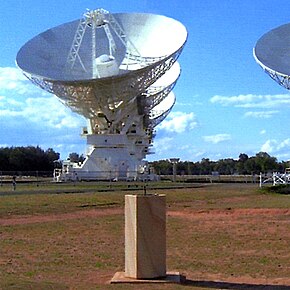The Paul Wild Observatory, also known as the Narrabri Observatory and Culgoora Observatory,[1] is an astronomical research facility located about 24 km west of Narrabri, New South Wales, Australia.[2] It is the home of the Australia Telescope Compact Array, and the Culgoora Solar Observatory.
 | |
| Alternative names | Narrabri Observatory |
|---|---|
| Named after | Paul Wild |
| Location | Narrabri, New South Wales, Australia |
| Coordinates | 30°18′50″S 149°33′43″E / 30.314°S 149.562°E |
| Website | www |
| Telescopes | |
The site itself and the Australia Telescope Compact Array are run by Australia's science agency, the CSIRO.[1] The current Solar Observatory is run by the Space Weather Services section of Australia's Bureau of Meteorology.[3][4]
The site is named in honour of Australian radio astronomer Paul Wild, who headed the team that built the instrument that the site was established for – the Culgoora Radioheliograph, the world's first radioheliograph[5] – which ran from 1967 to 1984.[6]
The Australia Telescope Compact Array began operating at the site in 1988.[7]
Current facilities
edit- The Australia Telescope Compact Array – a six-dish radio telescope interferometer[8]
- The Ionospheric Prediction Service (Space Weather Services) Culgoora Solar Observatory[9][4]
- A node of the Birmingham Solar Oscillations Network (BiSON)[10]
- An element of the Magnetic Data Acquisition System (MAGDAS) global magnetometer array[11][12]
-
Four antenna dishes of the Compact Array.
-
Dishes of the Compact Array, showing track.
-
A compact arrangement of dishes, at the north spur junction.
-
East-west track of Array, before construction of north spur. 6th dish in far distance.
Past facilities
edit- The Culgoora Radioheliograph[1][13][14]
- The CSIRO Culgoora Solar Observatory
- The Sydney University Stellar Interferometer (SUSI)[15][16]
-
An Antenna of Culgoora Radioheliograph, 1970s
-
7 of the 96 Antennae of Radioheliograph, c.1968
In the media
editThe children's/teen's television adventure series Sky Trackers was filmed at the site in 1993,[17] with the antenna dishes of the Australia Telescope Compact Array being prominently featured.
Other sites nearby
editIn addition to the Paul Wild Observatory, there is a history of astronomical research at other sites in the Narrabri area. The Narrabri Stellar Intensity Interferometer (NSII), the predecessor of SUSI, was located about 10 km north of Narrabri.[18]
At a site south of Narrabri, near the Bohena Creek, Durham University ran gamma ray telescopes[19] from 1986 to 2000.[20] The Bohena Creek site had previously been used for Sydney University's Giant Air Shower Recorder (SUGAR) for the detection of cosmic rays.[19]
See also
editReferences
edit- ^ a b c "Visitors Guide to the Narrabri Observatory". CSIRO Australia Telescope National Facility. 30 August 2019. Retrieved 28 February 2021.
- ^ "Narrabri, Paul Wild Observatory". www.csiro.au.
- ^ "About SWS". Australian Government Bureau of Meteorology Space Weather Services. Retrieved 6 March 2021.
- ^ a b "Culgoora Observatory". Australian Government Bureau of Meteorology Space Weather Services. Retrieved 28 February 2021.
- ^ Stewart, Ronald; Wendt, Harry; Orchiston, Wayne; Slee, Bruce (2011). "A Retrospective View of Australian Solar Radio Astronomy 1945-1960". In Orchiston, Wayne (ed.). Highlighting the History of Astronomy in the Asia-Pacific. Springer. p. 589. ISBN 978-1-4419-8160-8.
- ^ "Radio astronomy – observing explosions on the sun". CSIROpedia. 18 April 2013. Retrieved 28 February 2021.
- ^ CSIRO. "Australia Telescope Compact Array". www.csiro.au. Retrieved 5 September 2021.
- ^ "Australia Telescope Compact Array". www.narrabri.atnf.csiro.au. 8 July 2019.
- ^ "Travel to Narrabri". www.narrabri.atnf.csiro.au.
- ^ "Australian novelist writes about life at University of Birmingham's solar observatories". www.birmingham.ac.uk.
- ^ "Information for the Public". www.narrabri.atnf.csiro.au. 31 July 2020. Retrieved 28 February 2021.
- ^ Yomoto, Kiyohumi (November 2005). "MAGDAS_Project". International Centre for Space Weather Science and Education Kyushu University. Archived from the original on 31 July 2007. Retrieved 4 March 2021.
- ^ Labrum, N. R. (25 August 1972). "The Culgoora Solar Radio Observatory". Solar Physics. 27 (2): 496–504. Bibcode:1972SoPh...27..496L. doi:10.1007/BF00153122. S2CID 122609617.
- ^ "Australia Telescope Compact Array". CSIROpedia. 5 September 2014. Retrieved 28 February 2021.
- ^ The SUSI (Sydney University Stellar Interferometer), Narrabri,... | Download Scientific Diagram
- ^ Watson, Fred; Couch, Warrick (December 2017). "Astronomy in Australia" (PDF). The Messenger (170). European Southern Observatory: 4. "While SUSI achieved an excellent track record in high-resolution optical astronomy, it eventually closed in the face of competition from ESO’s Very Large Telescope Interferometer (VLTI) and other facilities."
{{cite journal}}: CS1 maint: postscript (link) - ^ Wallace, Alex (August 1993). "CSIRO - sky tracking across the universe and our television screens" (PDF). CoResearch - CSIRO's Staff Newsletter (354): 8.
- ^ Davis, John; Lovell, Bernard (2003). "Robert Hanbury Brown 1916-2002". Historical Records of Australian Science. 14: 4.
- ^ a b Mark R, Dickinson (October 1997). "Chapter 3: The University of Durham Atmospheric Cerenkov Telescopes". Very high energy gamma ray observations of southern hemisphere blazars (Ph.D. thesis). Durham University. p. 41.
- ^ "Gamma-Ray Astronomy Group | History | Australia". Durham University. Retrieved 1 March 2021.
External links
edit- Narrabri Observatory Public Information (CSIRO)
- Australia Telescope Compact Array - Fast Facts (CSIRO)
- Space Weather Services (IPS) Culgoora Solar Observatory (Australian Bureau of Meteorology)
- Birmingham Solar Oscillations Network (University of Birmingham)
- MAGDAS (Kyushu University)
- Paul Wild (1923-2008) (CSIROpedia)
- "A New Look at the Sun", a CSIRO film on the Culgoora Radioheliograph (CSIROpedia)
- "The Sun – Our Nearest Star", a CSIRO film on the CSIRO Culgoora Solar Observatory (CSIROpedia)
